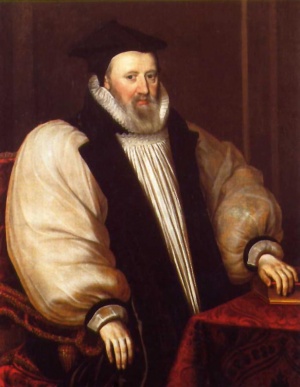George Abbot
From Textus Receptus
| Line 1: | Line 1: | ||
[[Image:George Abbot.jpg|300px|thumb|right|George Abbot]] | [[Image:George Abbot.jpg|300px|thumb|right|George Abbot]] | ||
{{King James Version Translation Committee}} | {{King James Version Translation Committee}} | ||
| - | George Abbot (October 19, 1562 – August 5, 1633) was an English divine and Archbishop of Canterbury. He also served as the fourth Chancellor of Trinity College, Dublin between 1612 and 1633. | + | George Abbot (October 19, [[1562 AD|1562]] – August 5, [[1633 AD|1633]]) was an English divine and Archbishop of Canterbury. He also served as the fourth Chancellor of Trinity College, Dublin between 1612 and 1633. |
==Biography== | ==Biography== | ||
Revision as of 08:58, 12 August 2016
George Abbot (October 19, 1562 – August 5, 1633) was an English divine and Archbishop of Canterbury. He also served as the fourth Chancellor of Trinity College, Dublin between 1612 and 1633.
Contents |
Biography
Early years
Born at Guildford in Surrey, where his father Maurice Abbot (died 1606) was a cloth-worker, he was taught at the Royal Grammar School, Guildford. He later studied, and then taught, at Balliol College, Oxford, was chosen Master of University College in 1597, and appointed Dean of Westminster in 1600. He was three times Vice-Chancellor of the University, and took a leading part in preparing the authorized version of the New Testament. In 1608 he went to Scotland with George Home, 1st Earl of Dunbar to arrange for a union between the churches of England and Scotland. He so pleased King James in this affair that he was made Bishop of Lichfield and Coventry in 1609 and was translated to the see of London a month afterwards.
Archbishop of Canterbury
Less than a year later, on March 4, 1611 Abbot was raised to the position of Canterbury. As archbishop, he defended the Apostolic Succession of the Anglican archbishops & bishops and the validity of the Church's priesthood in 1614. In consequence of the Nag's Head Fable, the archbishop invited certain Roman Catholics to inspect the register in the presence of six of his own episcopal colleagues, the details of which inspection were preserved. It was agreed by all parties that:
"The register agrees in every particular with what we know of the history of the times, and there exists not the semblance of a reason for pronouncing it a forgery." 1
In spite of his defense of the Catholic nature of the priesthood, his un-puritan instincts frequently led him not only into harsh treatment of Roman Catholics, but also into courageous resistance to the royal will, e.g. when he opposed the scandalous divorce suit of the Lady Frances Howard against the Earl of Essex, and again in 1618 when, at Croydon, he forbade the reading of the declaration permitting Sunday sports. He was naturally, therefore, a promoter of the match between the elector palatine, Frederick V, and the Princess Elizabeth, and a firm opponent of the projected marriage of the Prince of Wales with the Infanta of Spain. This policy brought upon him the hatred of William Laud (with whom he had previously come into collision at Oxford) and the court, though the King himself never forsook him.
In 1622, while hunting in Lord Zouch's park at Bramshill House in Hampshire, a bolt from his cross-bow aimed at a deer happened to strike one of the keepers, who died within an hour, and Abbot was so greatly distressed by the event that he fell into a state of settled melancholia. His enemies maintained that the fatal issue of this accident disqualified him for his office, and argued that, though the homicide was involuntary, the sport of hunting which had led to it was one in which no clerical person could lawfully indulge. The King had to refer the matter to a commission of ten, though he said that "an angel might have miscarried after this sort." The commission was equally divided, and the King gave a casting vote in the Archbishop's favour, though signing also a formal pardon or dispensation.
After this the Archbishop seldom appeared at the Council, chiefly on account of his infirmities. In 1625 he attended the King constantly, however, in his last illness, and performed the ceremony of the coronation of King Charles I. His refusal to license the assize sermon preached by Dr Robert Sibthorp at Northampton on February 22 1627, in which cheerful obedience was urged to the king's demand for a general loan, and the duty proclaimed of absolute non-resistance even to the most arbitrary royal commands, led Charles to deprive him of his functions as primate, putting them in commission. The need of summoning parliament, however, soon brought about a nominal restoration of the Archbishop's powers. His presence being unwelcome at court, he lived from that time in retirement, leaving Laud and his party in undisputed ascendancy. He died at Croydon on August 5 1633, and was buried at Guildford, his native place, where he had endowed a hospital with lands to the value of £300 a year.
Legacy
Abbot was a conscientious prelate, though narrow in view and often harsh towards both separatists and Roman Catholics. He wrote a large number of works, the most interesting being his discursive Exposition on the Prophet Jonah (1600), which was reprinted in 1845. His Geography, or a Brief Description of the Whole World (1599), passed through numerous editions.
Guildford remembers the Archbishop with a statue in the High Street, a pub and also a secondary school (George Abbot School) named after him. His tomb can be seen in Holy Trinity Church.

